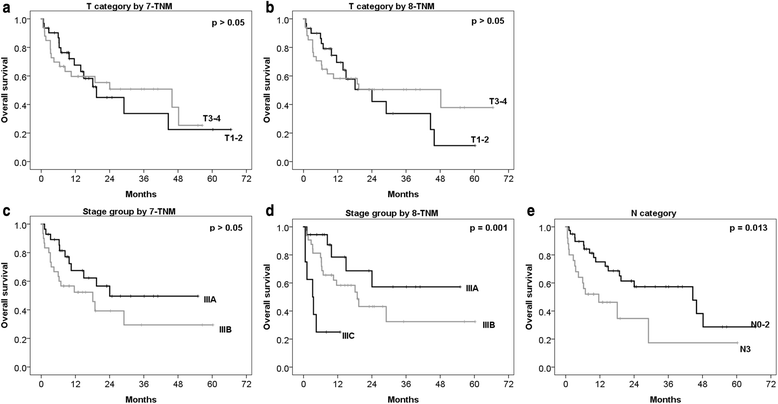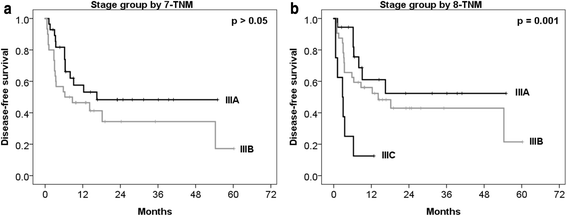Application of the new 8th TNM staging system for non-small cell lung cancer: treated with curative concurrent chemoradiotherapy
- PMID: 28732516
- PMCID: PMC5521086
- DOI: 10.1186/s13014-017-0848-2
Application of the new 8th TNM staging system for non-small cell lung cancer: treated with curative concurrent chemoradiotherapy
Abstract
Background: The eighth tumor, node, metastasis (TNM) staging system (8-TNM) for non-small cell lung cancer (NSCLC) was newly released in 2015. This system had limitation because most patients included in the analysis were treated with surgery. Therefore, it might be difficult to reflect prognosis of patients treated with curative concurrent chemoradiotherapy (CCRT). Purpose of this study was to investigate clinical impact of the newly published 8-TNM compared to the current seventh TNM staging system (7-TNM) for locally advanced NSCLC patients treated with CCRT.
Methods: New 8-TNM was applied to 64 patients with locally advanced NSCLC who were treated with CCRT from 2010 to 2015. Changes in T category and stage group by 8-TNM were recorded and patterns of change were evaluated. Survival was analyzed according to T category, N category, and stage group in each staging system, respectively.
Results: Among the total of 64 patients, 38 (59.4%) patients showed change in T category while 22 (34.4%) patients showed change in stage group using 8-TNM compared to 7-TNM. Survival curves were significantly separated in the 8-TNM stage group (p = 0.001) than those in the 7-TNM (p > 0.05). Especially, survival of newly introduced stage IIIC by 8-TNM was significantly lower than that of others. On the other hand, there was no significant survival difference between T categories in each staging system.
Conclusions: Subdivision of stage III into IIIA, IIIB, and IIIC by 8-TNM for patients treated with CCRT better reflected prognosis than 7-TNM. However, subdivision of T category according to tumor size in 8-TNM might be less significant.
Keywords: Chemoradiotherapy; Non-small cell lung cancer; Staging.
Conflict of interest statement
Ethics approval and consent to participate
The present study was approved by Institutional Review Board (IRB) of Gyeongsang National University Hospital (IRB number: 2017–03-014).
Consent for publication
Not applicable because this analysis has retrospective nature.
Competing interests
The authors declare that they have no competing interests.
Publisher’s Note
Springer Nature remains neutral with regard to jurisdictional claims in published maps and institutional affiliations.
Figures


References
-
- Paesmans M, Sculier JP, Libert P, Bureau G, Dabouis G, Thiriaux J, Michel J, Van Cutsem O, Sergysels R, Mommen P, et al. Prognostic factors for survival in advanced non-small-cell lung cancer: univariate and multivariate analyses including recursive partitioning and amalgamation algorithms in 1,052 patients. The European lung cancer working party. J Clin Oncol. 1995;13:1221–1230. doi: 10.1200/JCO.1995.13.5.1221. - DOI - PubMed
-
- Goldstraw P, Crowley J, Chansky K, Giroux DJ, Groome PA, Rami-Porta R, Postmus PE, Rusch V, Sobin L, International Association for the Study of Lung Cancer International Staging C, Participating I The IASLC lung cancer staging project: proposals for the revision of the TNM stage groupings in the forthcoming (seventh) edition of the TNM classification of malignant tumours. J Thorac Oncol. 2007;2:706–714. doi: 10.1097/JTO.0b013e31812f3c1a. - DOI - PubMed
-
- Groome PA, Bolejack V, Crowley JJ, Kennedy C, Krasnik M, Sobin LH, Goldstraw P, Committee IIS, Cancer R, Biostatistics, Observers to the C et al. The IASLC lung cancer staging project: validation of the proposals for revision of the T, N, and M descriptors and consequent stage groupings in the forthcoming (seventh) edition of the TNM classification of malignant tumours. J Thorac Oncol. 2007;2:694–705. doi: 10.1097/JTO.0b013e31812d05d5. - DOI - PubMed
-
- Postmus PE, Brambilla E, Chansky K, Crowley J, Goldstraw P, Patz EF, Jr, Yokomise H, International Association for the Study of Lung Cancer International Staging C, Cancer R, Biostatistics, Observers to the C et al. The IASLC lung cancer staging project: proposals for revision of the M descriptors in the forthcoming (seventh) edition of the TNM classification of lung cancer. J Thorac Oncol. 2007;2:686–693. doi: 10.1097/JTO.0b013e31811f4703. - DOI - PubMed
MeSH terms
LinkOut - more resources
Full Text Sources
Other Literature Sources
Medical

